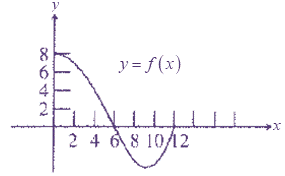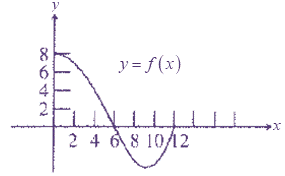
Concept explainers
(a)
H(0) with f being a continuous function.
(a)
Answer to Problem 57E
With f being a continuous function,
13y
Explanation of Solution
Given information:

Where,
f is a continuous function with domain [0,12].
We have
Substitute
Thus,
No area under the curve exists on the interval [0, 0], because this area will have no width.
(b)
Interval on which H is increasing.
(b)
Answer to Problem 57E
H(x) is increasing on [0, 6].
Explanation of Solution
Given information:

Where,
f is a continuous function with domain [0,12].
H is increasing on interval [a, b],
When
For
(a,b).
Since
And
For all
Thus,
H(x) is increasing on [0, 6].
(c)
Interval on which the graph of H concave up.
(c)
Answer to Problem 57E
H is concave up on the interval [9, 12].
Explanation of Solution
Given information:

Where,
f is a continuous function with domain [0,12].
For H to be concave up,
The second derivative needs to be positive.
Since
As well as
Thus,
In other words,
H is concave up when slope of the graph
According to graph,
This occurs when x is between 9 and 12.
Therefore,
H is concave up on the interval [9, 12].
(d)
Whether H(12) is positive or negative.
(d)
Answer to Problem 57E
H(12) is positive.
Explanation of Solution
Given information:

Where,
f is a continuous function with domain [0,12].
The region between curve and x-axis,
Since the net area of the region above the x-axis between 0 and 6 is larger than the net area of the region below the x-axis between 6 and 12,
The total region between the curve and x-axis will be positive.
Thus,
H(12) is positive.
(e)
Point at which H achieves maximum value.
(e)
Answer to Problem 57E
H achieves maximum value at
Explanation of Solution
Given information:

Where,
f is a continuous function with domain [0,12].
H(x) will achieve its maximum at an endpoint or a value of x.
Such that
Since
And
When
Then
Since
And
Then
Therefore,
H achieves its maximum value at
(f)
Point at which H achieves minimum value.
(f)
Answer to Problem 57E
H achieves minimum value at
Explanation of Solution
Given information:

Where,
f is a continuous function with domain [0,12].
H will achieve its minimum value at an endpoint or critical point.
From Part (e),
The only critical point was at
Then
H will achieve its minimum at one of its endpoints at
From Part (b),
Since
For all x between
H is always increasing.
That means
Therefore,
H achieves minimum value at
Chapter 6 Solutions
Calculus 2012 Student Edition (by Finney/Demana/Waits/Kennedy)
Additional Math Textbook Solutions
Calculus: Early Transcendentals (2nd Edition)
Calculus: Early Transcendentals (3rd Edition)
Precalculus Enhanced with Graphing Utilities (7th Edition)
Calculus & Its Applications (14th Edition)
 Calculus: Early TranscendentalsCalculusISBN:9781285741550Author:James StewartPublisher:Cengage Learning
Calculus: Early TranscendentalsCalculusISBN:9781285741550Author:James StewartPublisher:Cengage Learning Thomas' Calculus (14th Edition)CalculusISBN:9780134438986Author:Joel R. Hass, Christopher E. Heil, Maurice D. WeirPublisher:PEARSON
Thomas' Calculus (14th Edition)CalculusISBN:9780134438986Author:Joel R. Hass, Christopher E. Heil, Maurice D. WeirPublisher:PEARSON Calculus: Early Transcendentals (3rd Edition)CalculusISBN:9780134763644Author:William L. Briggs, Lyle Cochran, Bernard Gillett, Eric SchulzPublisher:PEARSON
Calculus: Early Transcendentals (3rd Edition)CalculusISBN:9780134763644Author:William L. Briggs, Lyle Cochran, Bernard Gillett, Eric SchulzPublisher:PEARSON Calculus: Early TranscendentalsCalculusISBN:9781319050740Author:Jon Rogawski, Colin Adams, Robert FranzosaPublisher:W. H. Freeman
Calculus: Early TranscendentalsCalculusISBN:9781319050740Author:Jon Rogawski, Colin Adams, Robert FranzosaPublisher:W. H. Freeman
 Calculus: Early Transcendental FunctionsCalculusISBN:9781337552516Author:Ron Larson, Bruce H. EdwardsPublisher:Cengage Learning
Calculus: Early Transcendental FunctionsCalculusISBN:9781337552516Author:Ron Larson, Bruce H. EdwardsPublisher:Cengage Learning





